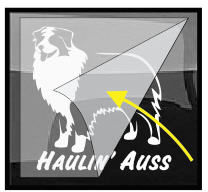 |
 |
 |
 |
Vinyl Decal ~ add text or leave blank, choose size and color.
NickerStickers Decals are Easy to Apply!Whether you've never, ever applied a decal before or are an old pro, NickerStickers go on smooth and easy and stick very well.
Before you start, WASH THE SURFACE!
Don't Use Window Cleaner!
We recommend you use plain old soap and water, 1/3 cup soap to 1 cup water. If there is any wax build up, use a scrubby. Finish with a lint free cloth to dry. You can add additional touch of extra cleaning with rubbing alcohol, mixed half and half with water. But soap and water is usually good enough.
Step 1. Peel the transfer tape with the decal stuck to it away from the waxy backing paper. The adhesive side of your decal is now exposed. Be careful! Don't get it dirty and don't touch it with your fingers. Use the clear transfer tape to hold because you'll be taking that off later anyway. 
Step 2. Using the transfer tape, roll your decal on to the surface to which you are applying, starting at one corner and laying it down. Once it is on the surface, rub on top of the clear transfer tape and decal using a credit card and working from the center out. Press lightly at first, then repeat more firmly. Repeat several times. 
Step 3. REMOVE THE TRANSFER TAPE. The decal is under the transfer tape. Pull the transfer tape up at a sharp angle beginning at one corner. Remove the clear tape on top of the decal and throw it away. Your decal should easily stick to the surface while you are pulling up the transfer tape. If it's not sticking solid, try leaving it on overnight and taking it off the next day. 
For more information on decal application, including applying large decals,
video instruction, and trouble shooting, click here:

Believed to have originated from the pre-history spotted horses of the region of Europe now known as Spain, the Knabstrupper is one of the oldest breed registries in Europe. Established in 1812, the Knabstrupper started with a single chestnut blanketed mare purchased by a Danish butcher named Flaeb from a Spanish cavalry officer. The mare, who became known as FLAEBEHOPPEN (which literally means “Flaeb’s mare), was purchased by Major Villars Lunn who owned an estate called “Knabstrupgaard” in Holbaek, Nordsealand, Denmark.
Flaeb’s mare was bred to a Fredricksborg stallion and produced a wildly colored stallion son who was named Flaebehingsten. Between the two of them, Flaebehoppen and Flaebehingsten were bred to a large variety of good quality horses, producing loudly colored offspring and grand offspring and establishing the Knabstrupper horses as some of the most sought after in Europe at that time.
A BREED ALMOST LOST By the 1870’s the breed’s continuation was severely threatened as the limited number of Knabstrupper horses lead to unavoidable problems of inbreeding. Then in 1891, a fire at the Lunn family stables destroyed 22 of its top breeding horses. By 1900, the breed’s numbers and quality had declined significantly. But supporters of the Knabstrupper horses continued to fight for the survival of the breed, and in 1947 the stud farm “Egemosegaard” attempted to reestablish the breed. In 1971, breeder Frede Nielsen brought three Appaloosa stallions to Denmark to infuse new blood into the breed. This was a logical step, as the American Appaloosa developed directly from the Spanish spotted horses that were brought to the New World from Europe by Cortez and Coronado in the early 1500’s. KIND TEMPERAMENT Knabstruppers are valued for their kind temperaments, high level of trainability, strength, stamina and good health as well as for their wonderful color. Over the past two centuries, there have come to be three rather distinct types of Knabstruppers: the Sport Horse type, the Baroque type and the Pony type. The Sport Horse type has been bred to excel in dressage, eventing and show jumping and has been developed by crossing the Knabstrupper with the warmblood sport horses of Europe, most notably the Danish Warmblood and the Trakehner. The Baroque type is a shorter, broader horse reminiscent of a carriage horse or war horse and was very popular as a circus horse. The Pony type is smaller still and is a favorite of children all over Europe. COLOR The Knabstrupper horse exhibits the same color patterns as the American Appaloosa, as they share the same color genes. The most popular color pattern is the leopard with its solid white background covered with black, bay or chestnut spots. Other patterns include the blanket, the snowflake, the snowcap and the “few spot,” an almost solid white horse that, when bred, always produces a foal with a spotted pattern of some kind.
Credit: American Knabstrupper Association www.knabstruppers.com
|
|
 |
 |
 |
 |

|